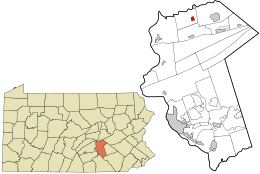Berrysburg, Pennsylvania facts for kids
Quick facts for kids
Berrysburg, Pennsylvania
|
|
|---|---|
|
Borough
|
|

Romberger-Stover House
|
|

Location in Dauphin County and the U.S. state of Pennsylvania.
|
|
| Country | United States |
| State | Pennsylvania |
| County | Dauphin |
| Settled | 1819 |
| Incorporated | 1871 |
| Government | |
| • Type | Borough Council |
| Area | |
| • Total | 0.61 sq mi (1.57 km2) |
| • Land | 0.61 sq mi (1.57 km2) |
| • Water | 0.00 sq mi (0.00 km2) |
| Elevation | 722 ft (220 m) |
| Population
(2020)
|
|
| • Total | 326 |
| • Density | 537.95/sq mi (207.64/km2) |
| Time zone | UTC-5 (Eastern (EST)) |
| • Summer (DST) | UTC-4 (EDT) |
| ZIP Code |
17005
|
| Area code(s) | 717 |
| FIPS code | 42-05856 |
Berrysburg is a small town, known as a "borough," in Dauphin County, Pennsylvania, United States. In 2020, about 324 people lived there. It is part of the larger Harrisburg metropolitan area.
Contents
History of Berrysburg
How Berrysburg Got Its Name
Long ago, Berrysburg was first known as Hellerstown. Later, it was renamed Berrysburg after the Berry family, who were early settlers in the area. The town was settled in 1819 and officially became a borough in 1871.
Important Buildings
A special old building in Berrysburg is the Romberger-Stover House. In 1980, this house was added to the National Register of Historic Places. This means it is an important historical place that is protected.
Geography of Berrysburg
Where Berrysburg Is Located
Berrysburg is found in the northern part of Dauphin County. It is in the eastern area of Mifflin Township. Even though it's near the township, Berrysburg is its own separate town.
Mountains and Roads
About 2 miles (3.2 km) north of Berrysburg, you'll find Mahantango Mountain. Two main roads, PA 25 and PA 225, meet in the borough.
- PA 25 goes east about 5 miles (8 km) to Gratz. It goes west about 9 miles (14 km) to Millersburg by the Susquehanna River.
- PA 225 goes north about 3 miles (5 km) to Pillow. It goes south about 4 miles (6.4 km) to Elizabethville.
The state capital, Harrisburg, is about 30 miles (48 km) south of Berrysburg.
Size of the Borough
According to the U.S. Census Bureau, Berrysburg covers a total area of about 0.61 square miles (1.6 square kilometers). All of this area is land.
Population of Berrysburg
| Historical population | |||
|---|---|---|---|
| Census | Pop. | %± | |
| 1870 | 451 | — | |
| 1880 | 476 | 5.5% | |
| 1890 | 426 | −10.5% | |
| 1900 | 398 | −6.6% | |
| 1910 | 377 | −5.3% | |
| 1920 | 329 | −12.7% | |
| 1930 | 395 | 20.1% | |
| 1940 | 426 | 7.8% | |
| 1950 | 386 | −9.4% | |
| 1960 | 434 | 12.4% | |
| 1970 | 443 | 2.1% | |
| 1980 | 447 | 0.9% | |
| 1990 | 376 | −15.9% | |
| 2000 | 354 | −5.9% | |
| 2010 | 368 | 4.0% | |
| 2020 | 324 | −12.0% | |
| 2021 (est.) | 324 | −12.0% | |
| Sources: | |||
How Many People Live Here?
In 2000, there were 354 people living in Berrysburg. These people made up 144 households and 102 families. The population density was about 519 people per square mile (200 people per square kilometer).
Who Lives in Berrysburg?
Most people in Berrysburg are White (99.15%). A small number are African American (0.56%) or Native American (0.28%). About 0.28% of the population identified as Hispanic or Latino.
Households and Families
Out of the 144 households in 2000:
- About 27.8% had children under 18 living with them.
- Most (61.8%) were married couples living together.
- About 7.6% were single mothers with no husband present.
- About 22.2% of households had someone living alone.
The average household had about 2.41 people, and the average family had about 2.83 people.
Age Groups
The population in Berrysburg is spread across different age groups:
- 19.5% were under 18 years old.
- 5.6% were between 18 and 24.
- 30.8% were between 25 and 44.
- 25.1% were between 45 and 64.
- 18.9% were 65 years or older.
The average age in Berrysburg was 41 years old. For every 100 females, there were about 93.4 males.
See also
 In Spanish: Berrysburg (Pensilvania) para niños
In Spanish: Berrysburg (Pensilvania) para niños



